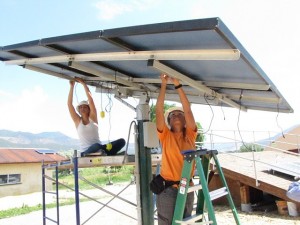 Yingli Green Energy, a leading solar energy company and one of the world’s largest vertically integrated photovoltaic (PV) manufacturers, which markets its products under the brand “Yingli Solar,” announced today that its U.S. subsidiary, Yingli Green Energy Americas, Inc., is the Presenting Sponsor of Solarthon, nonprofit solar installer GRID Alternatives’ annual fundraiser that brings together hundreds of individuals, teams, solar job trainees, and corporate participants to install multiple solar energy systems in one day for low-income homeowners. The first of the five events takes place on Saturday, September 10th in the Bayview-Hunters Point neighborhood in San Francisco.
Yingli Green Energy, a leading solar energy company and one of the world’s largest vertically integrated photovoltaic (PV) manufacturers, which markets its products under the brand “Yingli Solar,” announced today that its U.S. subsidiary, Yingli Green Energy Americas, Inc., is the Presenting Sponsor of Solarthon, nonprofit solar installer GRID Alternatives’ annual fundraiser that brings together hundreds of individuals, teams, solar job trainees, and corporate participants to install multiple solar energy systems in one day for low-income homeowners. The first of the five events takes place on Saturday, September 10th in the Bayview-Hunters Point neighborhood in San Francisco.
“We’re pleased to have worked with GRID Alternatives to install over 250 projects for low-income families to date and are proud to be their Official Solar Module Provider,” said Helena Kimball, Head of Marketing Communications, Yingli Americas. “These unique Solarthon events are a great way to advance our mission to bring cost-effective solar power to the communities who need it most, while creating local job opportunities and growth.” “Every single GRID Alternatives home installation provides thousands of dollars in savings for working families and two days of on the job training for ten job seekers – and we average 15 home installations per week. Because of Yingli Solar’s support, we have been able to multiply this impact hundreds of times over,” said Erica Mackie, Co-Founder, GRID Alternatives.
As Presenting Sponsor and Official Module Provider of GRID Alternatives, Yingli Solar will supply solar modules for 50 participating families from neighborhoods in San Francisco, San Diego, Fresno, San Louis Obispo and Los Angeles during the five Solarthon block parties. The systems will eliminate more than 4,400 tons of greenhouse gas emissions and generate $1.3 million worth of renewable energy savings for families living on very low incomes. The sponsorship of these Solarthons is part of the collaboration between Yingli Solar and GRID Alternatives to install 1 MW of solar energy systems for 400 low-income families throughout 2011. These installations will create thousands of hands-on job training opportunities in PV installation while helping underserved families with immediate financial savings.















